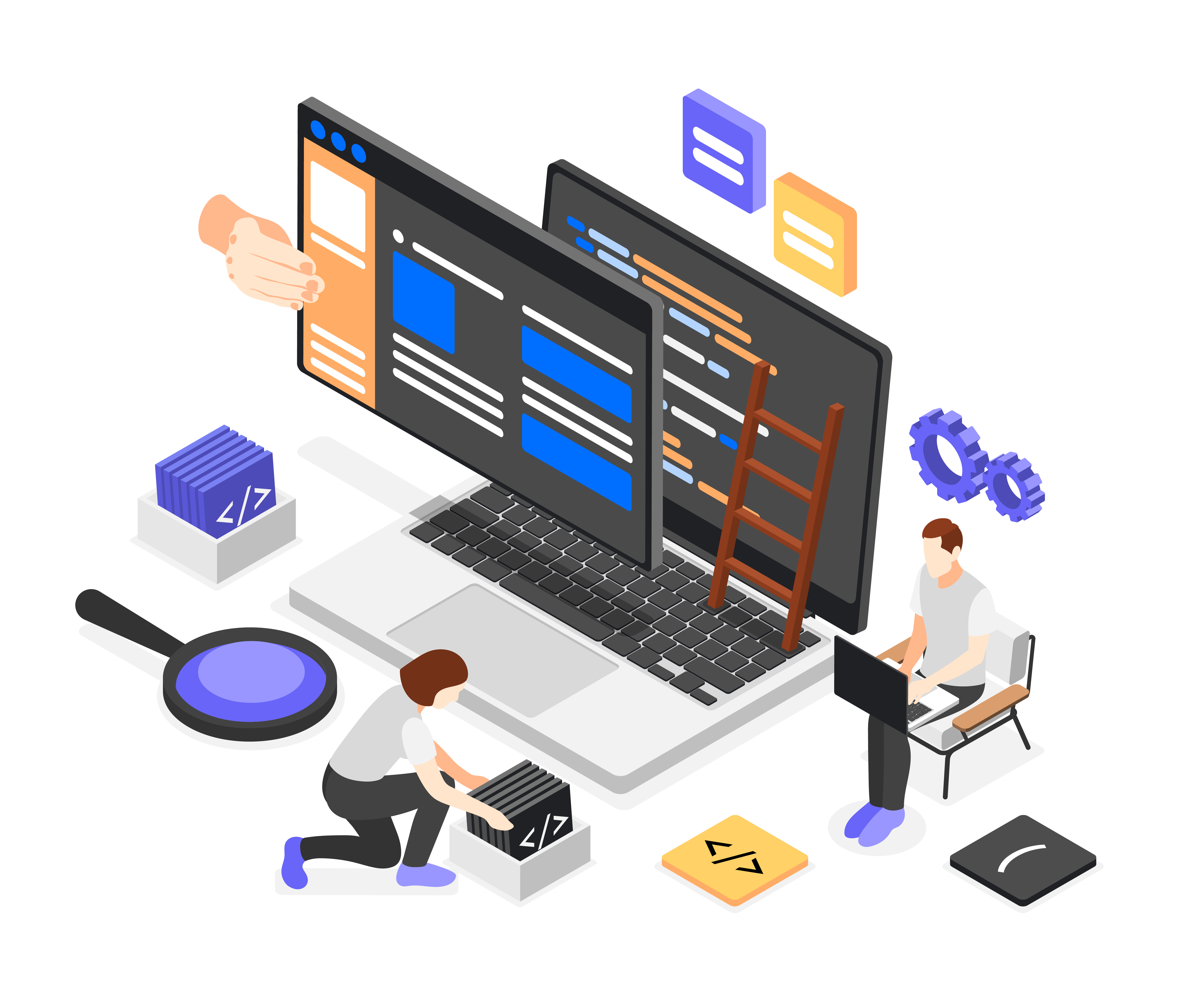You want to launch a digital project without getting lost in technology, while maintaining a clear direction from the start. This practical guide to developing custom web applications brings together the essentials to understand, decide and move forward peacefully towards an application adapted to your business.
What is custom web application development?
Custom web application development consists in creating an application designed for your business, your users, your data and your goals. Unlike standard tools, everything is adapted to your business. The application becomes a fully-fledged product that meets real uses, without having to twist your processes to enter generic software.
A custom web application is not just code. It is an evolving digital tool, capable of managing complex workflows, of connecting to your APIs, of centralizing data, of operating on mobile, and of giving a fluid experience to all your users, internal or customers.
What differentiates custom from existing software
Ready-to-use software starts from a generic model. A tailor-made web application is based on your specific needs. The gap can be seen in design control, functionalities, iteration management, technical quality, API integration possibilities and the way in which the team manages the project. Where software imposes its limits, tailor-made solutions are built around your idea.
Why businesses are winning
Businesses that adopt a custom web application often seek to streamline their operations, improve the user experience or create a business tool that evolves over time. Custom development makes it possible to eliminate the duplication of tools, to avoid manual data manipulations, to offer a simpler interface to the teams and to guarantee software quality adapted to future growth.
When should you choose a custom web application?
Going custom becomes relevant when your current tool blocks the company in its progress. Some of the signs come back often. Teams repeat tasks by hand, users juggle multiple sites or applications, data management becomes risky, or the internal software no longer follows business reality.
Customization is perfect for projects that seek to streamline internal activity, create a customer portal, launch a mobile digital application or redesign an aging tool that has become too expensive to maintain. A redesign is often an opportunity to review design, data, architecture and functionalities in order to start again on a healthy basis.
A common mistake is to think that customizing is only for very large companies. In reality, many small businesses and SMEs find it a net gain in time, budget and quality when a standard tool no longer allows them to grow peacefully.
The stages of a custom web application development project
Even if each studio or agency has its own method, a successful project follows a very clear structure. This structure reduces risks, accelerates iterations and allows the developer and the client to move forward in line with the objectives.
Step 1: framing and prototype
Framing is used to clarify the product before writing a single line of code. We define the users, the paths, the objectives, the data and the business constraints. This stage often ends with a prototype. This prototype is not yet software, but it gives a concrete vision of the experience, design and logic of the tool.
Step 2: functional design and design
Once the prototype is validated, the team details the functionalities, builds the screens and organizes the navigation. The design is based on the user experience and the real needs of the profession. This is where the application takes shape. Good design makes life easier for users, improves internal management, and reduces future technical questions.
Step 3: technical development and integrations
Development consists in transforming the prototype into a real web application. Developers create the architecture, code, databases, databases, APIs, automations, and all the necessary integrations. Depending on the project, the application can be designed for mobile, desktop, or both. The team advances in iterations of a few weeks to ensure steady progress.
Step 4: tests, quality and online release
This step guarantees the reliability of the software before it is put online. We check the data, the behavior of the functionalities, the security, the mobile compatibility, the user journey and the edge cases. Once validated, the application goes online. We often talk about push in production.
Step 5: maintenance and evolutions
A custom web application is never static. It must evolve with the company, its users and new needs. Maintenance includes updates, enhancements, added features, data management, and regular code optimizations.
How much does custom web application development cost
The Cost depends especially the complexity of the business, the data to be processed, the number of users, the APIs, the level of design and the functional scope.
A small project can start with a reasonable budget if the scope is under control, especially if an MVP is possible. A comprehensive platform, with multiple user roles, advanced data management, and advanced automations will require a larger investment.
To optimize your budget, the best approach is to work in stages. The prototype allows ideas to be validated. The MVP allows you to move forward quickly. Iterations allow features to be added continuously, while maintaining control over budget and quality.
How to choose an agency or a studio to create a custom web application
Choosing an agency is a key step. You will be working with a team for several weeks, sometimes several months. The right partner understands your business, knows how to popularize the technique, masters web development and offers clear management tools.
An experienced agency focuses on code quality, data security, API reliability, and design consistency. A healthy relationship with the customer makes it possible to streamline projects and keep communication simple, even on technical subjects.
Before signing, it is useful to check the studio's ability to support the company over time. A digital project does not end when it is put online. It requires maintenance, evolutions and regular iterations.
Low code in custom development
Low code plays an important role in current projects. It is becoming an interesting solution to go faster, prototype or reduce the cost of the first steps. For some companies, it makes it possible to launch an application in a few weeks, to test a digital product or to simplify internal management.
But low code does not replace conventional code in all cases. Complex projects, advanced business needs, demanding mobile applications, or critical API integrations require a more robust architecture. The hybrid approach combines low code for speed and traditional code for quality, performance, and flexibility.
The essential functionalities of a modern custom web application
A modern application should offer a smooth experience, simple management, clear paths, and a solid structure. Some features are often used in business projects.
User management allows you to define roles, rights, and accesses. Business modules centralize important data. API integrations connect the tool to the company's other platforms. Automations reduce manual tasks. Dashboards provide a clear view of data. Notifications keep teams up to date in real time. Mobile optimization ensures a consistent experience across devices.
Practical advice for the success of your tailor-made project
A successful project progresses through regular iterations. The framing should remain simple and user oriented. Features should be defined based on real need, not based on an exhaustive list. Communication between the project team and the studio must remain transparent to continuously adjust the roadmap.
The prototype is the basis for refining the experience. Tests should take place from the first versions. Data must be structured from the start. Maintenance should not be seen as a cost but as a long-term guarantee of quality.
One last thing before you start
Creating a custom web application is a real lever for companies that want to save time, improve the user experience and structure their data. If you want to move forward on a project, clarify an idea, understand a budget, or explore a redesign, The Scroll team supports SMEs and equipped companies that want to build a reliable, sustainable and well-thought-out tool.
Faq
The price depends on scope, features, APIs, and business needs. A prototype or an MVP makes it possible to reduce the initial budget and to frame the project before the final code.
Most projects advance in a few weeks for an MVP and several months for a complete platform. The duration depends on the iterations, design, data, and integrations required.
A tailor-made web application is often sufficient if the objective is to optimize internal management or a customer portal. A mobile or hybrid version becomes useful if users are often on the go.
Security is based on architecture, access control, reliable APIs, user role management, code quality, and regular updates.
Une agence garantit la qualité, la technique, la gestion, la maintenance et l’évolution du produit. Le no code est utile pour prototyper mais atteint vite ses limites sur les projets métier complexes.


.svg)















.webp)

.svg)
.svg)
.svg)